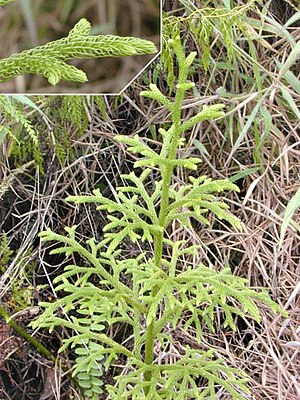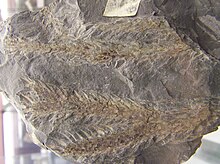Bear moss plants
| Bear moss plants | ||||||||||||
|---|---|---|---|---|---|---|---|---|---|---|---|---|

|
||||||||||||
| Systematics | ||||||||||||
|
||||||||||||
| Scientific name of the subdivision | ||||||||||||
| Lycopodiophytina | ||||||||||||
| Reveal | ||||||||||||
| Scientific name of the class | ||||||||||||
| Lycopodiopsida | ||||||||||||
| Bartl. |
The bear moss plants ( Lycopodiopsida ) are a class of vascular plants . It currently consists of three families with herbaceous representatives. In the Carboniferous Age , tree-shaped representatives dominated large areas of the northern hemisphere, they were the basis for today's hard coal deposits in these areas.
features
As with the other vascular plants, the sporophyte is the dominant generation here. The sporophyte is usually forked (dichotomous). The shoot axes carry simple, not articulated leaves that are small and narrow ( microphylls ). In terms of habit , the bear mosses are similar to mosses , but are not more closely related to them than the other vascular plants. Today's representatives are usually small and herbaceous, but the fossil representatives also included trees 40 meters high.
The sporangia stand individually in the armpits or at the base of leaves (sporophylls). The sporophylls are usually united at the end of shoot sections to form sporophyll stands ("bloom"). There are exceptions for some fossil groups. Most groups are isospore , so they only develop spores of the same size. Some groups, the moss ferns and Isoetales , are heterosporous , so they develop large female and small male spores. The spermatozoids are usually two flagellated , a distinguishing feature to the ferns , the other group of vascular spore plants. Only Isoetes has multi-flagellated spermatozoids.
Systematics
External system
The bear moss plants are the sister group of all other vascular plants, so the ferns are more closely related to the seed plants than to the bear moss plants:
| Vascular plants |
|
||||||||||||||||||||||||
|
|
Internal system
The recent representatives of the class are divided into three orders , to which currently only one family belongs:
- Lycopodiales with the club moss family (Lycopodiaceae).
- Isoetales with the bream family (Isoetaceae).
- Selaginellales with the moss fern family (Selaginellaceae).
There are also four orders of extinct club moss plants:
- Drepanophycales
- Protolepidodendrales
- Lepidodendrales , for example with the shed trees.
- Pleuromeiales
Paleobotany

The oldest representatives of the bear moss plants have been known since the Silurian , from the middle Devonian onwards , together with the calamites , they replaced the psilophytes as the predominant group. In the original representatives, the leaves and the sporophylls were still forked. Some tree-like representatives are among the main representatives of the hard coal forests of the Carboniferous . In the Carboniferous the club moss plants had their greatest diversity, especially in the order Lepidodendrales with the "shed trees" of the families Lepidodendraceae and Diaphorodendraceae , and the "seal trees" (in the family Sigillariaceae ). Some tree-shaped species still reach the Rotliegend , since then there have only been herbaceous representatives.
Receipts and further information
literature
- Peter Sitte , Elmar Weiler , Joachim W. Kadereit , Andreas Bresinsky , Christian Körner : Textbook of botany for universities . Founded by Eduard Strasburger . 35th edition. Spektrum Akademischer Verlag, Heidelberg 2002, ISBN 3-8274-1010-X .
- Walter Zimmermann : Phylogeny of the plants. An overview of facts and problems. 2nd, completely revised edition. Gustav Fischer, Stuttgart 1959, pp. 289-295.
Individual evidence
- ^ Alan R. Smith, Kathleen M. Pryer, Eric Schuettpelz, Petra Korall, Harald Schneider, Paul G. Wolf: A classification for extant ferns. In: Taxon. Volume 55, No. 3, 2006, ISSN 0040-0262 , pp. 705-731, abstract, ( Memento from February 12, 2017 in the Internet Archive ) PDF file .
- ^ Thomas N. Taylor, Edith L. Taylor, Michael Krings: Paleobotany. The Biology and Evolution of Fossil Plants . 2nd Edition. Elsevier / Academic Press, Amsterdam et al. 2009, ISBN 978-0-12-373972-8 , pp. 266 ( limited preview in Google Book search).